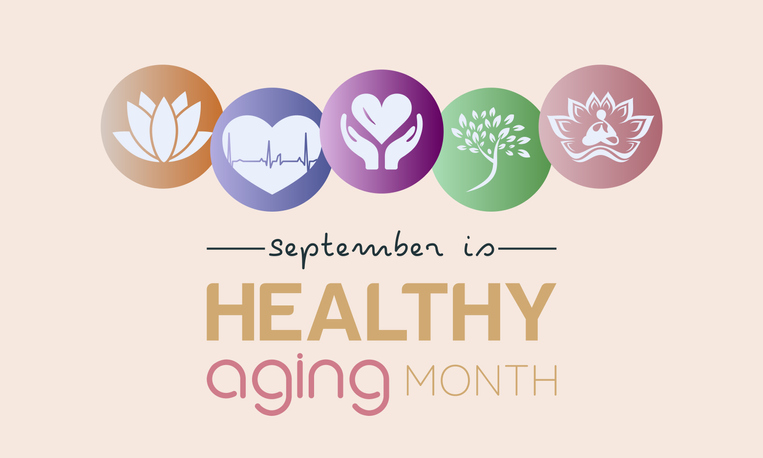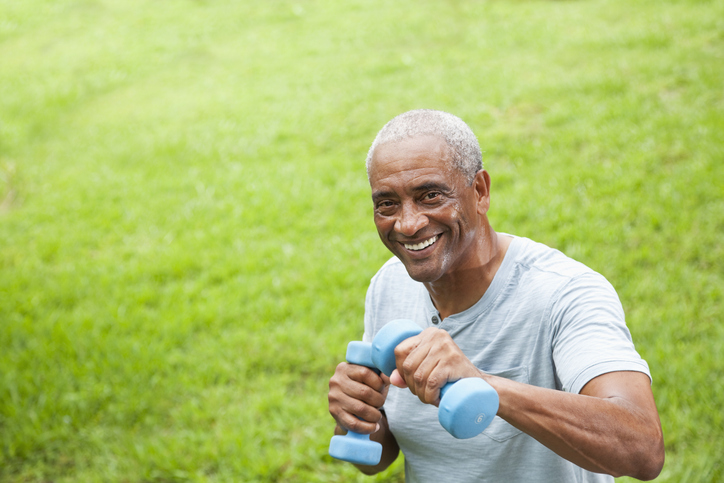September is Healthy Aging Month. The Weight of This Is Up to You!

September is Healthy Aging Month. In order to have a healthier mindset about aging in general, we should probably stop using the term anti-aging. The word anti means opposed to or against. I, for one, am not against aging.
"Do not complain about growing old. It is a privilege denied to many." - Mark Twain
I am, however, against aging in a way that does not promote healthy and happy longevity. Although there is nothing wrong with wanting to look good or maintain a youthful appearance for as long as possible, healthy aging is not about a face serum to reduce the appearance of wrinkles. It is about maintaining mobility, independence and freedom from chronic diseases such as heart disease and type 2 diabetes.
We cannot control everything. Disease can happen, but we do have more power than we might realize.

In order to age healthfully, it is always good to have a basic understanding of the difference between intrinsic and extrinsic aging. Basically, intrinsic aging, also called chronological aging, is the aging that is not within our control. It is a natural biological process that will occur as long as we are living and breathing. Intrinsic aging is also genetically determined. So, some people might “age better” than others just based on being blessed with “good genes.”
As with most things regarding health and wellness, our genes do not determine our destiny. There is also extrinsic aging, which we have a lot of control over. Extrinsic aging occurs due to environmental factors and lifestyle choices such as diet, sleep hygiene, whether we are active or sedentary or whether we smoke or not.
So for example, if Bob has genes that are programmed for slow intrinsic aging but makes poor lifestyle choices, he is very likely to look older and not age as healthfully as Bill who is predisposed to more rapid intrinsic aging but maintains a nutrient-rich diet and healthy weight and avoids smoking and excessive alcohol consumption.
To a large degree we can prevent extrinsic aging. As you probably know already, physical activity is great for such prevention. One overlooked component of exercise for healthy and happy longevity is strength training (also called resistance training). In my opinion, building muscle really is one of the closest ways to “drink from the fountain of youth.” Let’s go over why.
Approach building and maintaining muscle like an investment. You are going to get the most bang for your buck if you start young, but it is never too late to start investing and building that wealth (your muscle).
Muscle helps prevent falls, and falls are one of the biggest obstacles to happy and healthy aging and longevity.
“Falls are the leading cause of fatal and nonfatal injuries for older Americans. Falls threaten seniors' safety and independence, and generate enormous economic and personal costs,” according to the National Council on Aging (NCOA).
“However, falling is not an inevitable result of aging. Through practical lifestyle adjustments, evidence-based falls prevention programs, and clinical-community partnerships, the number of falls among seniors can be substantially reduced.”
We naturally lose muscle as we age. Age-related muscle loss is called sarcopenia (which actually means “lack of flesh”). In addition to experiencing diminished strength, muscle loss may also cause a lack of balance. Less strength and balance is the perfect recipe for a fall. In addition to this, our bones become more brittle as we age and we also experience bone loss. So a fall is much more likely to result in a broken hip or perhaps worse - a fatal head injury.
(What’s also so great about strength training is that in addition to building muscle it also helps delay bone loss).
“This decrease in muscle tissue begins around the age of 50 years, but becomes more dramatic beyond the 60th year of life,” reports the National Institutes of Health (NIH).
Some medical sources say muscle loss begins as young as after the age of 30.
“Decreased strength and power contribute to the high incidence of accidental falls observed among the elderly and can compromise quality of life. Moreover, sarcopenia has been linked to several chronic afflictions that are common among the aged, including osteoporosis, insulin resistance and arthritis.”

This is huge. I don’t think many people are aware that strength training and building muscle may also be very effective for preventing a variety of illnesses. This is why it is so important to look beyond the number on the scale. A person can be thin and considered to be at a healthy weight. However, without sufficient muscle this person can actually be considered skinny fat and very prone to falls and poor aging.
I bet I really have your attention now! According to a recent study, both aerobic and strength training significantly improved skin elasticity and upper dermal structure in sedentary, middle-aged Japanese women. Furthermore, strength training appeared to improve dermal thickness. Skin gets thinner as we age.

How to approach strength training, especially as we age.
This is going to look different for everyone, but I think in general it is important to understand that you do not have to lift extremely heavy amounts of weight to have results. You don’t want to over do it, as this can lead to an injury.
I highly recommended checking out this guide provided by the Centers for Disease Control and Prevention (CDC). What is so motivating is that the CDC mentions that there are people who successfully started weight training in their 70s, 80s and even 90s!
For more information on how to be proactive about building muscle and increasing your chance for happy and healthy longevity, check out these pH blogs:
- Hustle For That Muscle!
- Vitamin C - The Nutrient That May Help You Muscle Your Way Through Life
- Study Shows Older Adults May Need a Protein Intervention
- Avoid Falls From Age Related Muscle Loss!
- Benefits of Strength Training for Women
- Looking to Maintain or Build Muscle? Put Down that Cigarette!
- Dick Van Dyke, 96, Works Out. Age Is No Excuse!
- Be Proactive and Invest In Your Bone Health
- When It Comes to Exercise, There Is No Such Thing As “Age Appropriate”
Kick your feet up, have a cup of tea and read through these blogs. I am confident you will feel more knowledgeable and motivated to invest in not one of the biggest anti-agers (remember, I don’t like that word) but one of the most effective strategies for attaining happy and healthy longevity.
Enjoy your healthy life!
Disclaimer: This article is not intended to provide medical advice. Please consult with your doctor or another competent healthcare practitioner to get specific medical advice for your situation.
The pH professional health care team includes recognized experts from a variety of health care and related disciplines, including physicians, attorneys, nutritionists, nurses, and certified fitness instructors. This team also includes the members of the pH Medical Advisory Board, which constantly monitors all pH programs, products, and services. To learn more about the pH Medical Advisory Board, click here.







